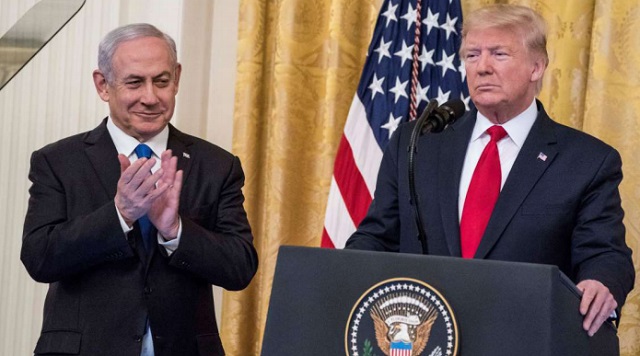
It has nothing to do with peace
| FRED KAPLAN | President Trump and Israeli Prime Minister Benjamin Netanyahu unveiled their Middle East peace plan on Jan.28. While it’s more substantive than many expected, it doesn’t amount to a peace plan at all.
First, the fact that the Palestinians played no role in negotiating or vetting the document means, by itself, that this is an imposition—something like the surrender terms handed down by a victorious army—rather than an accord reached by two parties.
Second, it declares the existence of a Palestinian state with a capital on the outskirts of East Jerusalem and the prospect of a U.S. embassy—but it also prohibits this state from forming an army, meaning it is not really a sovereign state after all.
Third, it freezes the expansion of Israeli settlements for the next four years—but it sanctifies all the settlements erected to date, allows more houses to be built on land already held, and annexes all occupied land, including all the holy sites in all of Jerusalem, to become officially part of Israel.
If any other state pulled such a move unilaterally, it would be widely denounced as a violation of international law. Until Trump, every U.S. president since 1967—Republican and Democrat—has refused to recognise the occupied territories as part of Israel: in part for moral reasons, in part to nudge Israel into a treaty that would involve trading space for security. However hard to reach, that is the precondition for a lasting peace, and it is now off the table.
Finally, it hands this Palestinian not-quite-state $28 billion for economic development—but only if they take the deal. Yet without real control over the state and a formal surrender of territory, without reciprocation, no Palestinian leader could take this deal and stay in power.
No doubt Netanyahu and Trump’s son-in-law, Jared Kushner, who led the U.S. team on this project, are well aware of these limitations. It’s quite likely they don’t care. In their eyes, the Palestinians are no longer the force in Middle East politics that they once were—and, from a Realpolitik perspective, they’re right. Years ago, the common slogan held that peace in the Middle East runs through Jerusalem: in other words, the region wouldn’t be peaceful until Israel and the Palestinians reached a two-state settlement.
However, even back then, the Arab leaders didn’t really care much about the Palestinians. As Malcolm Kerr argued in his classic book `The Arab Cold War’, they used the Palestinian struggle against Israel as a cover for their own domestic troubles. Now, with the Sunni Arab nations all but aligned (at least informally) with Israel in opposition to their common enemy, Iran, the cover is shed and the theatrics are over. Several of these nations released statements on Trump’s plan ranging from mild criticism to outright enthusiasm.
Kushner and Netanyahu might believe or hope that, once the Palestinians realise they have nowhere to go, no allies to rally for solidarity, they’ll swallow hard and take the deal. As Ian Bremmer, president of the Eurasia Group, sums up the calculation: They’ll come onboard, once they realise they have no one else to turn to.
Or, as Kushner himself put it, in an interview with CNN’s Christiane Amanpour, the plan is “a great plan,” and if the Palestinians reject it, “they’re going to screw up another opportunity, like they’ve screwed up every other opportunity that they’ve ever had in their existence.”
Fine words to coax an alienated people onboard a plan that’s not of their making and that few of them could possibly desire.
Kushner has been at this since his father-in-law became president. At his inauguration party, Trump thanked him for his help in the campaign and promised him a diplomatic portfolio, saying, “If you can’t produce peace in the Middle East, nobody can”—an odd declaration since Kushner, then 35, had no experience or qualifications for such a heavy task, except that he was Jewish and his parents were longtime friends with Netanyahu.
Why is this plan rolling out now, three years later? Probably because Trump and Netanyahu are both facing elections—Trump in the wake of an impeachment, Netanyahu in the wake of a criminal indictment. They both hope that a big peace banner, even if it signifies little, will boost their prospects. (Netanyahu’s main political rival, Gen. Benjamin Gantz, showed up at the celebration too, suggesting that, in Israeli politics anyway, the calculation has some validity.)
Motives aside, what is likely to happen next? The Palestinians won’t accept the plan. The Arab neighbors will look the other way. The Israelis will act as if the plan is a done deal. They’ll announce that all of the occupied territories are now part of Israel; the United States and maybe a few other countries will recognise the annexation; and the trends in Middle Eastern politics—the thickening alliance between Israel and the Sunnis, the sharpening tensions between the Sunni and Shiite powers, and the continued presence (and, with this, possibly the intensification) of Hamas and Hezbollah militias in the contested territories, with occasional eruptions of violence—will continue.
This is not a peace plan, it’s a power play—for domestic and regional politics—and the plan’s drafters know it.
****
Fred Kaplan is a journalist and author of the weekly column `War Stories’ that covers international relations in Slate magazine. He has a new book this January titled `The Bomb: Presidents, Generals, and the Secret History of Nuclear War’.
 The Independent Uganda: You get the Truth we Pay the Price
The Independent Uganda: You get the Truth we Pay the Price



